2006 BMW 550I SEDAN tire pressure reset
[x] Cancel search: tire pressure resetPage 93 of 259
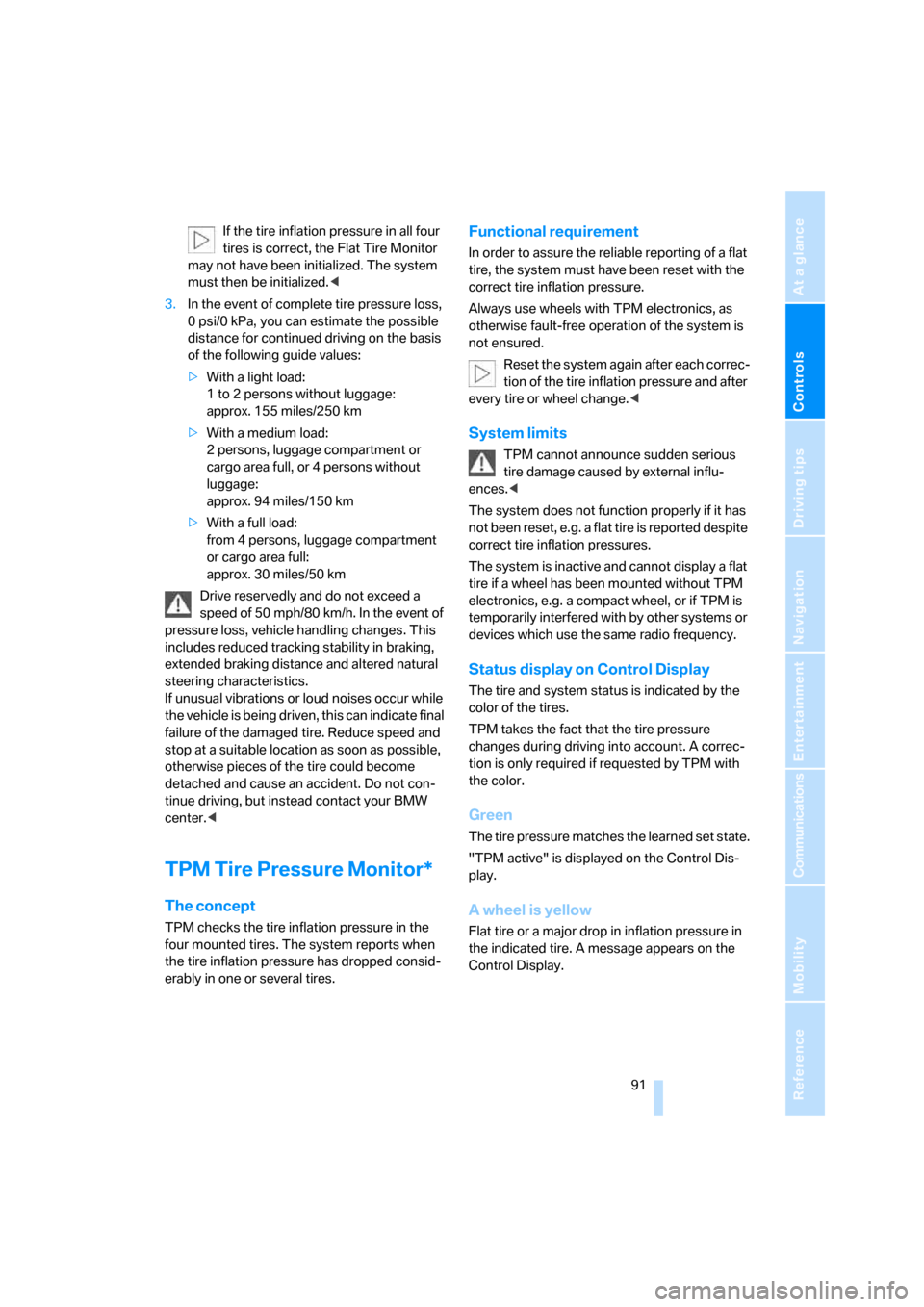
Controls
91Reference
At a glance
Driving tips
Communications
Navigation
Entertainment
Mobility
If the tire inflation pressure in all four
tires is correct, the Flat Tire Monitor
may not have been initialized. The system
must then be initialized.<
3.In the event of complete tire pressure loss,
0 psi/0 kPa, you can estimate the possible
distance for continued driving on the basis
of the following guide values:
>With a light load:
1 to 2 persons without luggage:
approx. 155 miles/250 km
>With a medium load:
2 persons, luggage compartment or
cargo area full, or 4 persons without
luggage:
approx. 94 miles/150 km
>With a full load:
from 4 persons, luggage compartment
or cargo area full:
approx. 30 miles/50 km
Drive reservedly and do not exceed a
speed of 50 mph/80 km/h. In the event of
pressure loss, vehicle handling changes. This
includes reduced tracking stability in braking,
extended braking distance and altered natural
steering characteristics.
If unusual vibrations or loud noises occur while
the vehicle is being driven, this can indicate final
failure of the damaged tire. Reduce speed and
stop at a suitable location as soon as possible,
otherwise pieces of the tire could become
detached and cause an accident. Do not con-
tinue driving, but instead contact your BMW
center.<
TPM Tire Pressure Monitor*
The concept
TPM checks the tire inflation pressure in the
four mounted tires. The system reports when
the tire inflation pressure has dropped consid-
erably in one or several tires.
Functional requirement
In order to assure the reliable reporting of a flat
tire, the system must have been reset with the
correct tire inflation pressure.
Always use wheels with TPM electronics, as
otherwise fault-free operation of the system is
not ensured.
Reset the system again after each correc-
tion of the tire inflation pressure and after
every tire or wheel change.<
System limits
TPM cannot announce sudden serious
tire damage caused by external influ-
ences.<
The system does not function properly if it has
not been reset, e.g. a flat tire is reported despite
correct tire inflation pressures.
The system is inactive and cannot display a flat
tire if a wheel has been mounted without TPM
electronics, e.g. a compact wheel, or if TPM is
temporarily interfered with by other systems or
devices which use the same radio frequency.
Status display on Control Display
The tire and system status is indicated by the
color of the tires.
TPM takes the fact that the tire pressure
changes during driving into account. A correc-
tion is only required if requested by TPM with
the color.
Green
The tire pressure matches the learned set state.
"TPM active" is displayed on the Control Dis-
play.
A wheel is yellow
Flat tire or a major drop in inflation pressure in
the indicated tire. A message appears on the
Control Display.
Page 94 of 259

Technology for comfort, convenience and safety
92
All wheels are yellow
Flat tire or a major drop in inflation pressure in
several tires. A message appears on the Control
Display.
Gray
The system cannot detect a flat tire.
Reasons for this can be:
>TPM is being reset
>Temporary interference due to systems or
devices which use the same radio fre-
quency
>Malfunction
Resetting system
Reset the system again after each correc-
tion of the tire inflation pressure and after
every tire or wheel change.<
Resetting finishes during driving, which can be
interrupted at any time. When driving resumes,
resetting is continued automatically. Do not
reset the system when driving with a compact
wheel
*.
iDrive, for explanation of principle, refer to
page16.
1.Press the button.
This opens the start menu.
2.Press the controller to open the menu.
3.Select "Vehicle settings" and press the
controller.
4.Select "TPM" and press the controller.
5.Start the engine, but do not start driving.
6.Select "Reset" and press the controller.7.Select "Yes" and press the controller.
8.Start to drive.
The tires are shown in gray and
"Resetting TPM..." is displayed.
After a few minutes of driving, the set tire infla-
tion pressures in the tires are applied as the set
values to be monitored. Resetting finishes dur-
ing driving. The tires are shown in gray on the
Control Display and "Status: TPM active" is dis-
played again.
If a flat tire is detected during resetting
and applying the tire inflation pressures,
all tires are shown in yellow on the Control Dis-
play. The message "Tire low!" is displayed.<
Message with low tire inflation
pressure
The warning lamp lights up yellow. A
message appears on the Control Dis-
play. In addition, an acoustic signal
sounds. There is a flat tire or extensive inflation
pressure loss.
1.Reduce speed and stop the vehicle care-
fully. Avoid sudden braking and steering
maneuvers.
2.Check whether your vehicle is equipped
with standard tires or run-flat tires.
You will recognize run-flat tires by a
circular symbol containing the letters
RSC on the side of the tire, refer to
page201.<
Page 95 of 259
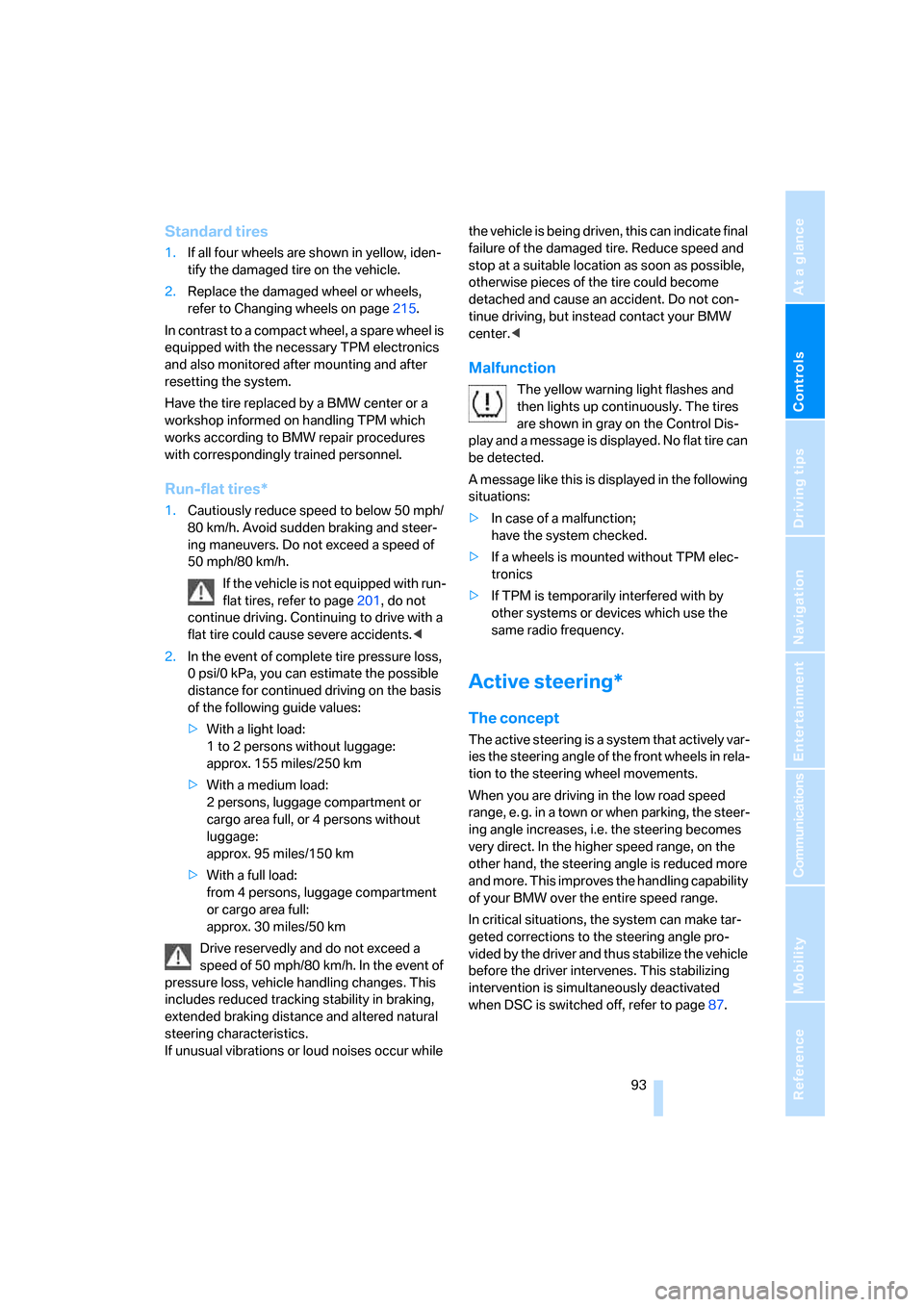
Controls
93Reference
At a glance
Driving tips
Communications
Navigation
Entertainment
Mobility
Standard tires
1.If all four wheels are shown in yellow, iden-
tify the damaged tire on the vehicle.
2.Replace the damaged wheel or wheels,
refer to Changing wheels on page215.
In contrast to a compact wheel, a spare wheel is
equipped with the necessary TPM electronics
and also monitored after mounting and after
resetting the system.
Have the tire replaced by a BMW center or a
workshop informed on handling TPM which
works according to BMW repair procedures
with correspondingly trained personnel.
Run-flat tires*
1.Cautiously reduce speed to below 50 mph/
80 km/h. Avoid sudden braking and steer-
ing maneuvers. Do not exceed a speed of
50 mph/80 km/h.
If the vehicle is not equipped with run-
flat tires, refer to page201, do not
continue driving. Continuing to drive with a
flat tire could cause severe accidents.<
2.In the event of complete tire pressure loss,
0 psi/0 kPa, you can estimate the possible
distance for continued driving on the basis
of the following guide values:
>With a light load:
1 to 2 persons without luggage:
approx. 155 miles/250 km
>With a medium load:
2 persons, luggage compartment or
cargo area full, or 4 persons without
luggage:
approx. 95 miles/150 km
>With a full load:
from 4 persons, luggage compartment
or cargo area full:
approx. 30 miles/50 km
Drive reservedly and do not exceed a
speed of 50 mph/80 km/h. In the event of
pressure loss, vehicle handling changes. This
includes reduced tracking stability in braking,
extended braking distance and altered natural
steering characteristics.
If unusual vibrations or loud noises occur while the vehicle is being driven, this can indicate final
failure of the damaged tire. Reduce speed and
stop at a suitable location as soon as possible,
otherwise pieces of the tire could become
detached and cause an accident. Do not con-
tinue driving, but instead contact your BMW
center.<
Malfunction
The yellow warning light flashes and
then lights up continuously. The tires
are shown in gray on the Control Dis-
play and a message is displayed. No flat tire can
be detected.
A message like this is displayed in the following
situations:
>In case of a malfunction;
have the system checked.
>If a wheels is mounted without TPM elec-
tronics
>If TPM is temporarily interfered with by
other systems or devices which use the
same radio frequency.
Active steering*
The concept
The active steering is a system that actively var-
ies the steering angle of the front wheels in rela-
tion to the steering wheel movements.
When you are driving in the low road speed
range, e. g. in a town or when parking, the steer-
ing angle increases, i.e. the steering becomes
very direct. In the higher speed range, on the
other hand, the steering angle is reduced more
and more. This improves the handling capability
of your BMW over the entire speed range.
In critical situations, the system can make tar-
geted corrections to the steering angle pro-
vided by the driver and thus stabilize the vehicle
before the driver intervenes. This stabilizing
intervention is simultaneously deactivated
when DSC is switched off, refer to page87.
Page 198 of 259
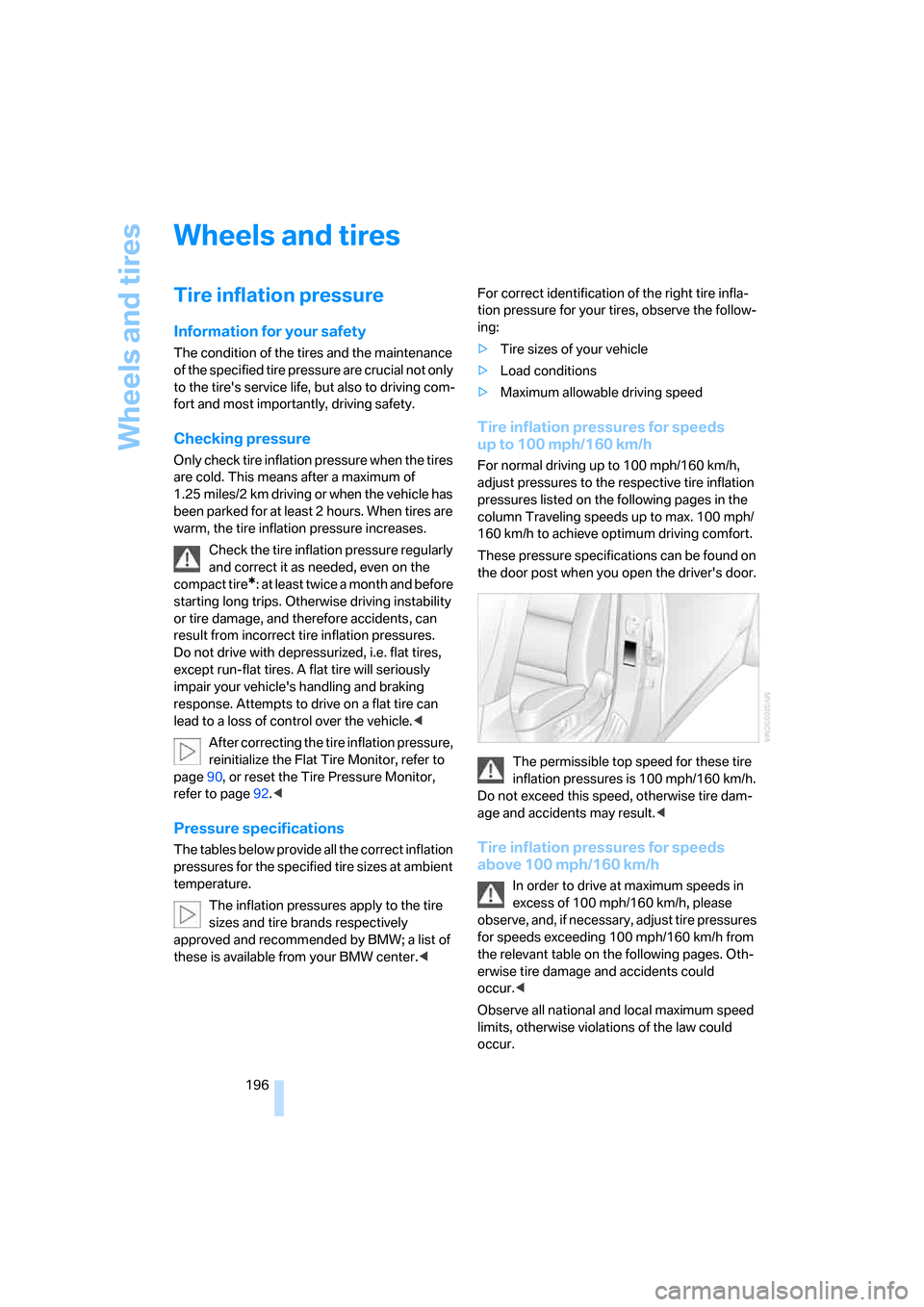
Wheels and tires
196
Wheels and tires
Tire inflation pressure
Information for your safety
The condition of the tires and the maintenance
of the specified tire pressure are crucial not only
to the tire's service life, but also to driving com-
fort and most importantly, driving safety.
Checking pressure
Only check tire inflation pressure when the tires
are cold. This means after a maximum of
1.25 miles/2 km driving or when the vehicle has
been parked for at least 2 hours. When tires are
warm, the tire inflation pressure increases.
Check the tire inflation pressure regularly
and correct it as needed, even on the
compact tire
*: at least twice a month and before
starting long trips. Otherwise driving instability
or tire damage, and therefore accidents, can
result from incorrect tire inflation pressures.
Do not drive with depressurized, i.e. flat tires,
except run-flat tires. A flat tire will seriously
impair your vehicle's handling and braking
response. Attempts to drive on a flat tire can
lead to a loss of control over the vehicle.<
After correcting the tire inflation pressure,
reinitialize the Flat Tire Monitor, refer to
page90, or reset the Tire Pressure Monitor,
refer to page92.<
Pressure specifications
The tables below provide all the correct inflation
pressures for the specified tire sizes at ambient
temperature.
The inflation pressures apply to the tire
sizes and tire brands respectively
approved and recommended by BMW; a list of
these is available from your BMW center.
ing:
>Tire sizes of your vehicle
>Load conditions
>Maximum allowable driving speed
Tire inflation pressures for speeds
up to 100 mph/160 km/h
For normal driving up to 100 mph/160 km/h,
adjust pressures to the respective tire inflation
pressures listed on the following pages in the
column Traveling speeds up to max. 100 mph/
160 km/h to achieve optimum driving comfort.
These pressure specifications can be found on
the door post when you open the driver's door.
The permissible top speed for these tire
inflation pressures is 100 mph/160 km/h.
Do not exceed this speed, otherwise tire dam-
age and accidents may result.<
Tire inflation pressures for speeds
above 100 mph/160 km/h
In order to drive at maximum speeds in
excess of 100 mph/160 km/h, please
observe, and, if necessary, adjust tire pressures
for speeds exceeding 100 mph/160 km/h from
the relevant table on the following pages. Oth-
erwise tire damage and accidents could
occur.<
Observe all national and local maximum speed
limits, otherwise violations of the law could
occur.
Page 219 of 259
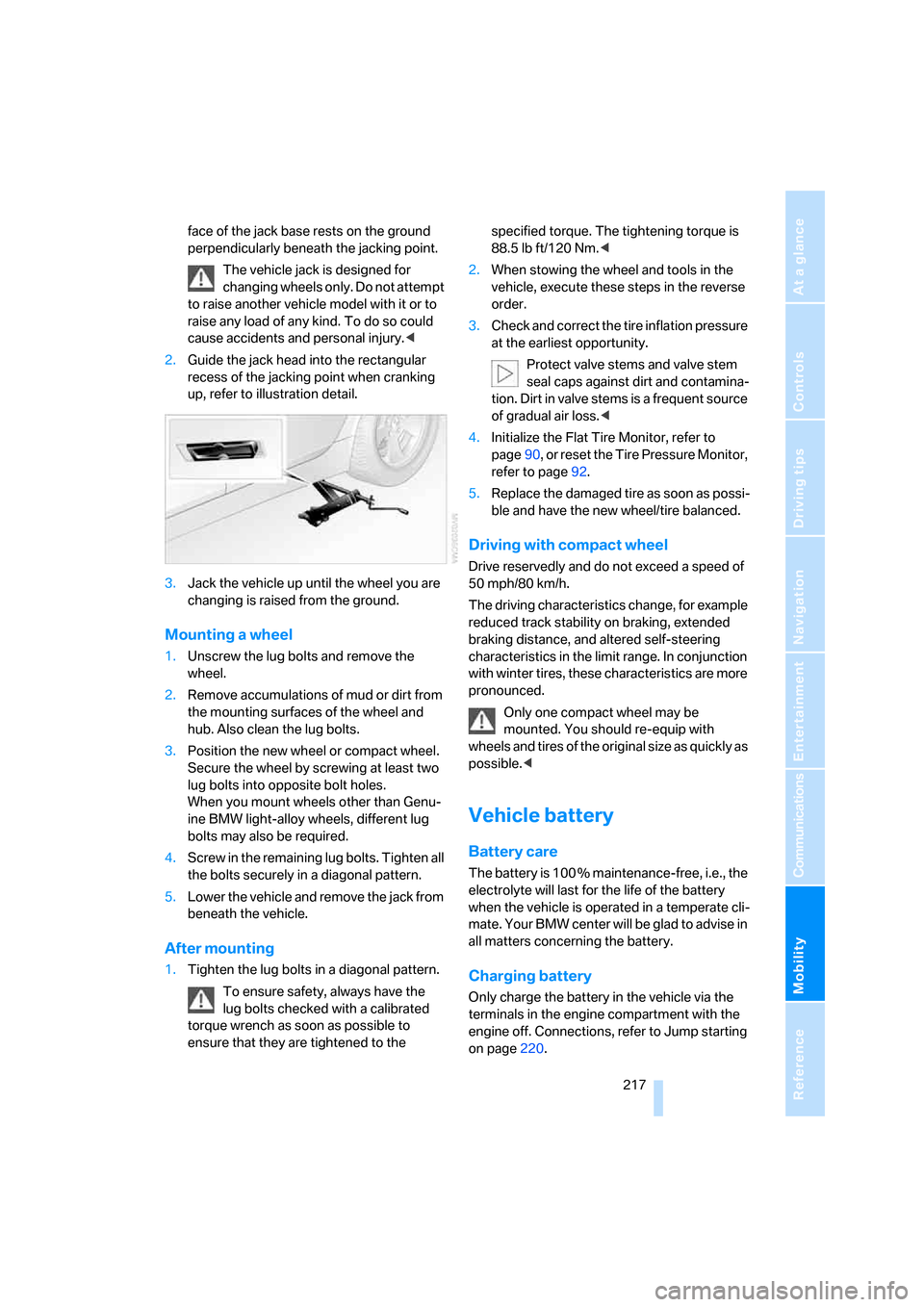
Mobility
217Reference
At a glance
Controls
Driving tips
Communications
Navigation
Entertainment
face of the jack base rests on the ground
perpendicularly beneath the jacking point.
The vehicle jack is designed for
changing wheels only. Do not attempt
to raise another vehicle model with it or to
raise any load of any kind. To do so could
cause accidents and personal injury.<
2.Guide the jack head into the rectangular
recess of the jacking point when cranking
up, refer to illustration detail.
3.Jack the vehicle up until the wheel you are
changing is raised from the ground.
Mounting a wheel
1.Unscrew the lug bolts and remove the
wheel.
2.Remove accumulations of mud or dirt from
the mounting surfaces of the wheel and
hub. Also clean the lug bolts.
3.Position the new wheel or compact wheel.
Secure the wheel by screwing at least two
lug bolts into opposite bolt holes.
When you mount wheels other than Genu-
ine BMW light-alloy wheels, different lug
bolts may also be required.
4.Screw in the remaining lug bolts. Tighten all
the bolts securely in a diagonal pattern.
5.Lower the vehicle and remove the jack from
beneath the vehicle.
After mounting
1.Tighten the lug bolts in a diagonal pattern.
To ensure safety, always have the
lug bolts checked with a calibrated
torque wrench as soon as possible to
ensure that they are tightened to the specified torque. The tightening torque is
88.5 lb ft/120 Nm.<
2.When stowing the wheel and tools in the
vehicle, execute these steps in the reverse
order.
3.Check and correct the tire inflation pressure
at the earliest opportunity.
Protect valve stems and valve stem
seal caps against dirt and contamina-
tion. Dirt in valve stems is a frequent source
of gradual air loss.<
4.Initialize the Flat Tire Monitor, refer to
page90, or reset the Tire Pressure Monitor,
refer to page92.
5.Replace the damaged tire as soon as possi-
ble and have the new wheel/tire balanced.
Driving with compact wheel
Drive reservedly and do not exceed a speed of
50 mph/80 km/h.
The driving characteristics change, for example
reduced track stability on braking, extended
braking distance, and altered self-steering
characteristics in the limit range. In conjunction
with winter tires, these characteristics are more
pronounced.
Only one compact wheel may be
mounted. You should re-equip with
wheels and tires of the original size as quickly as
possible.<
Vehicle battery
Battery care
The battery is 100 % maintenance-free, i.e., the
electrolyte will last for the life of the battery
when the vehicle is operated in a temperate cli-
mate. Your BMW center will be glad to advise in
all matters concerning the battery.
Charging battery
Only charge the battery in the vehicle via the
terminals in the engine compartment with the
engine off. Connections, refer to Jump starting
on page220.
Page 249 of 259
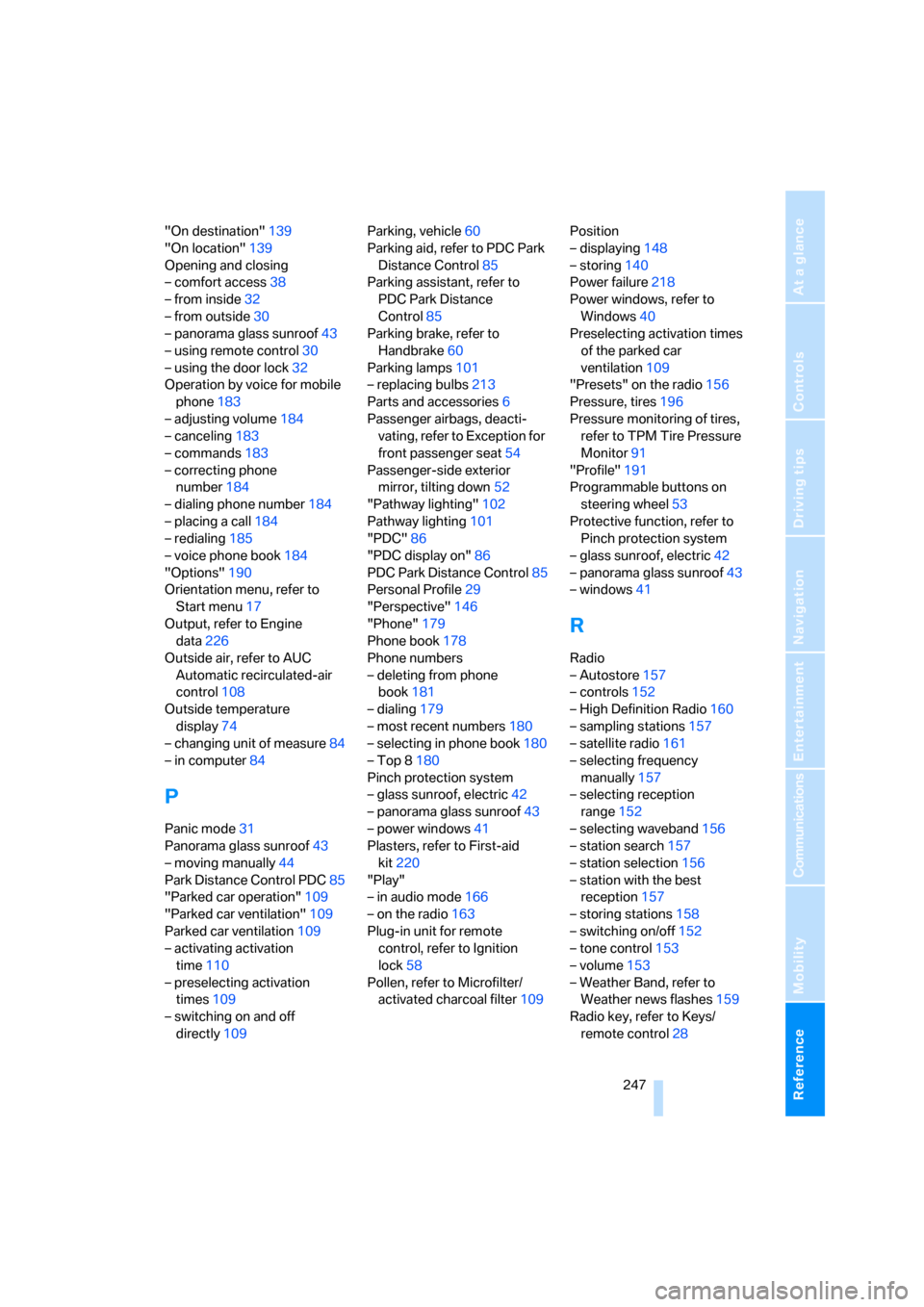
Reference 247
At a glance
Controls
Driving tips
Communications
Navigation
Entertainment
Mobility
"On destination"139
"On location"139
Opening and closing
– comfort access38
– from inside32
– from outside30
– panorama glass sunroof43
– using remote control30
– using the door lock32
Operation by voice for mobile
phone183
– adjusting volume184
– canceling183
– commands183
– correcting phone
number184
– dialing phone number184
– placing a call184
– redialing185
– voice phone book184
"Options"190
Orientation menu, refer to
Start menu17
Output, refer to Engine
data226
Outside air, refer to AUC
Automatic recirculated-air
control108
Outside temperature
display74
– changing unit of measure84
– in computer84
P
Panic mode31
Panorama glass sunroof43
– moving manually44
Park Distance Control PDC85
"Parked car operation"109
"Parked car ventilation"109
Parked car ventilation109
– activating activation
time110
– preselecting activation
times109
– switching on and off
directly109Parking, vehicle60
Parking aid, refer to PDC Park
Distance Control85
Parking assistant, refer to
PDC Park Distance
Control85
Parking brake, refer to
Handbrake60
Parking lamps101
– replacing bulbs213
Parts and accessories6
Passenger airbags, deacti-
vating, refer to Exception for
front passenger seat54
Passenger-side exterior
mirror, tilting down52
"Pathway lighting"102
Pathway lighting101
"PDC"86
"PDC display on"86
PDC Park Distance Control85
Personal Profile29
"Perspective"146
"Phone"179
Phone book178
Phone numbers
– deleting from phone
book181
– dialing179
– most recent numbers180
– selecting in phone book180
– Top 8180
Pinch protection system
– glass sunroof, electric42
– panorama glass sunroof43
– power windows41
Plasters, refer to First-aid
kit220
"Play"
– in audio mode166
– on the radio163
Plug-in unit for remote
control, refer to Ignition
lock58
Pollen, refer to Microfilter/
activated charcoal filter109Position
– displaying148
– storing140
Power failure218
Power windows, refer to
Windows40
Preselecting activation times
of the parked car
ventilation109
"Presets" on the radio156
Pressure, tires196
Pressure monitoring of tires,
refer to TPM Tire Pressure
Monitor91
"Profile"191
Programmable buttons on
steering wheel53
Protective function, refer to
Pinch protection system
– glass sunroof, electric42
– panorama glass sunroof43
– windows41
R
Radio
– Autostore157
– controls152
– High Definition Radio160
– sampling stations157
– satellite radio161
– selecting frequency
manually157
– selecting reception
range152
– selecting waveband156
– station search157
– station selection156
– station with the best
reception157
– storing stations158
– switching on/off152
– tone control153
– volume153
– Weather Band, refer to
Weather news flashes159
Radio key, refer to Keys/
remote control28
Page 253 of 259

Reference 251
At a glance
Controls
Driving tips
Communications
Navigation
Entertainment
Mobility
Starting off on slopes, refer to
Starting assistant125
Start menu, iDrive17
"Start route guidance"138
"Start service"189
"State / Province" for desti-
nation entry134
"State inspection"78
Station, refer to Radio156
"Stations", presets163
"Status"78
Status of this Owner's Manual
at time of printing5
Steering wheel
– adjustment52
– buttons on steering
wheel11
– easy entry/exit52
– heating52
– lock58
– locking58
– memory47
– programmable buttons53
"Steering wheel buttons"53
Steering-wheel shift buttons,
refer to Shift paddles62
Steering with variable ratio,
refer to Active steering93
Steptronic, refer to Automatic
transmission with
Steptronic63
"Stop" for stopwatch82
"Stopwatch"82
Stopwatch81
Storage area package119
Storage compartments114
"Store in address book" for
navigation system140
"Store" on the radio158,163
Storing current position140
Storing radio stations158
Storing sitting position, refer
to Seat, mirror and steering
wheel memory47
Storing tires202
Straps, refer to Loading128
"Street" for destination
entry135Summer tires, refer to Wheels
and tires196
Sun blinds112
"Surround Settings", refer to
Tone control154
SW, waveband156
Switches, refer to Cockpit10
Switching between high
beams and low beams,
automatic, refer to High-
beam assistant103
Switching cooling function on
and off107
Switching off engine60
Switching off tilt alarm
sensor38
Switching on
– audio152
– CD changer152
– CD player152
– radio152
Switching on hour signal83
Swiveling headlamps, refer to
Adaptive Head Light102
Symbols4
– indicator/warning lamps13
T
Tachometer74
"Tailgate"36
Tailgate33,35
– automatic operation36
– locking and unlocking from
inside32
– opening from inside, Sports
Wagon35
Tail lamps213
– replacing bulbs213
Tank contents, refer to
Capacities230
Target cursor for
navigation138
Technical alterations, refer to
For your own safety5
Technical data226
Telematic, refer to
TeleService,
BMW Assist187Telephone, refer to Mobile
phone174
"Telephone list"53
TeleService187
– enabling187
– services offered188
Temperature
– adjusting in upper body
region106
– adjusting with automatic
climate control106
– of coolant, refer to Coolant
temperature74
Temperature display
– outside temperature74
– setting units84
– temperature warning74
Temperature warning74
Tempomat, refer to Cruise
control66
"Terminate services"190
"Text language"84
"Theater", refer to Tone
control154
The individual vehicle5
Third brake lamp, refer to
Center brake lamp214
Through-loading system116
Tightening torque of the lug
bolts, refer to After
mounting217
Tilting down passenger-side
exterior mirror52
"Time"83
"Time format"83
Timer, refer to Preselecting
activation time109
"Timer 1" for parked car
ventilation110
"Timer 2" for parked car
ventilation110
Tire inflation pressures196
Tire pressure loss90,91
Tire pressure monitoring,
refer to Flat Tire Monitor89
Tire Pressure Monitor
TPM91
Tire Quality Grading200
Page 254 of 259

Everything from A to Z
252 Tire replacement, new wheels
and tires201
Tires
– age200
– air loss90,92
– breaking-in124
– changing201
– condition201
– damage201
– flat tire, refer to Changing
wheels215
– inflation pressure196
– new wheels and tires201
– pressure monitoring89
– pressure monitoring, refer to
TPM Tire Pressure
Monitor91
– replacing215
– retreaded tires202
– run-flat tires201
– size199
– tread201
– wear indicators201
– wheel/tire combination201
– winter tires202
"Tone"153
Tone dialing method182
Tone in audio mode
– adjusting153
– middle setting155
Tone on locking/unlocking31
Tools, refer to Onboard
toolkit211
"Top 8" for mobile phone180
Torque
– engine226
– lug bolts, refer to After
mounting217
Touch tone dialing, refer to
Tone dialing method182
Tow fitting221
Towing221
– tow fitting221
"Town / City" for destination
entry134
Tow-starting221,223
"TPM"92TPM Tire Pressure
Monitor91
– resetting system92
– system limits91
– warning light92
Tracks
– random play sequence168
– sample scan167
Track width, refer to
Dimensions227
Traction-assist feature, refer
to DSC Dynamic Stability
Control86
Traction control, refer to DSC
Dynamic Stability
Control86
Traffic congestion, refer to
Bypassing route
sections148
Transmission
– automatic transmission with
Steptronic63
– deactivating selector lever
interlock on automatic
transmission with
Steptronic64
– manual transmission60
– SMG Sequential Manual
Transmission61
– starting assistant125
Transporting children
safely54
Transport securing device,
refer to Securing cargo128
Tread depth, refer to Minimum
tire tread201
Treble, refer to Tone
control153
"Treble", tone control154
"Trip computer"77
Trip computer76
Trip-distance counter, refer to
Trip odometer74
"Triple turn signal
activation"65
Trip odometer74
Turning circle, refer to
Dimensions227Turn signals64
– indicator lamp12
– replacing bulbs213
U
Underbody protection, refer to
Caring for your vehicle
brochure
Uniform Tire Quality Grading/
UTQR200
"Units"84
Units
– average fuel
consumption84
– temperature84
Universal garage-door
opener, refer to Integrated
universal remote
control111
Universal remote control111
"Unlock button"30
Unlocking
– from inside33
– from outside30
– without key, refer to Comfort
access38
Unlocking without key, refer to
Comfort access38
"Update services"190
"Use current location as
address"140,142
Used batteries
– refer to Disposal218
– refer to Replacing battery40